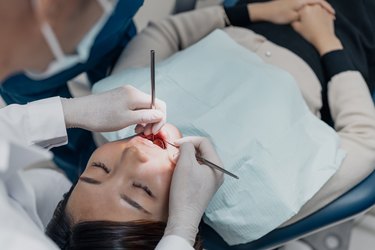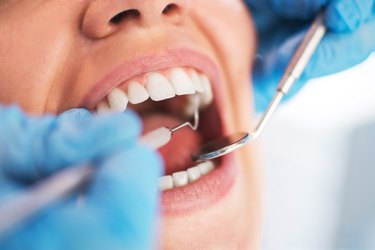
Almost half of U.S. adults 30 and older have gum disease, according to the Centers for Disease Control and Prevention (CDC), and about 8 percent have what's considered to be severe gum disease, per July 2018 research in The Journal of the American Dental Association, a phase associated with tooth loss that may be linked with other health conditions like diabetes.
Early gum disease — also called periodontal disease — can be easily treated and even reversed. Once it reaches a certain point, though, the disease can only be managed, not cured, per the American Dental Association (ADA).
Video of the Day
Video of the Day
Here, learn what causes gum disease, how it's treated and how to prevent it.
What Is Gum Disease?
Gum disease, aka periodontal disease or periodontitis, is a bacterial infection that starts in the soft tissue of your gums. If it's not properly treated, it can destroy your gum tissue over time and lead to a host of oral health problems.
Some 700 species of bacteria and other microbes reside naturally in our mouths, according to the National Institutes of Health (NIH). They thrive on sugar from the foods we eat and form plaque, a sticky, invisible film that builds up on your teeth, explains Deborah Foyle, DDS, clinical associate professor in the department of periodontics at Texas A&M School of Dentistry in Dallas.
If not removed — with brushing, flossing and regular dental check-ups — that plaque hardens into tartar, which can trigger a wave of tooth and gum decay.
Types of Gum Disease
There are two main types of periodontal disease:
- Gingivitis is early gum disease. It affects the line where your gums touch your teeth and usually produces mild symptoms (like red, swollen gums that bleed when you brush). Diligent oral hygiene can stop it in its tracks. "Gingivitis is easily reversible," says Dr. Foyle. "It's curable without any lasting damage provided you catch it early enough."
- Periodontitis is what happens if gingivitis isn't treated. Plaque spreads under the gum line and the gums start to detach from the teeth, creating pockets. These pockets harbor more bacteria. The infection grows and digs deeper into the gum tissue. Eventually, it can reach the jawbone, which then can no longer anchor the teeth. The most severe form of gum disease is chronic periodontitis, according to the University of Illinois Chicago College of Dentistry (UIC).
Some experts also refer to four gum disease stages: "initial," "early," "established" and "advanced." This is based on a seminal March 1976 scientific review in Laboratory Investigation.
While research is still ongoing, chronic periodontitis has been linked to a higher risk of diabetes, lung disease, heart disease, rheumatoid arthritis and stroke.
What Causes Gum Disease?
Several factors can contribute to the buildup of plaque and tartar that leads to gum disease. Chief among them is smoking or using other forms of tobacco.
According to the CDC, smokers are twice as likely to develop gum disease as nonsmokers. Not only do smokers produce more plaque, the habit also reduces the amount of oxygen available in the bloodstream to help damaged gums heal, per the Oral Health Foundation. The lack of bloodflow may also mask early symptoms of bleeding, according to UIC.
Other risk factors include:
- Poor oral hygiene
- Crooked teeth, which are more difficult to clean
- Family history of gum disease
- Changing hormones during pregnancy
- Diabetes
- Obesity
- Certain medications, such as steroids, oral contraceptives and calcium channel blockers (used to lower blood pressure)
- A high-starch, high-sugar diet
- Obstructive sleep apnea
- HIV/AIDS, leukemia and other conditions that compromise the immune system
- Stress
- Too much alcohol
- Defective fillings or bridges that don't fit well
- Grinding your teeth (bruxism)
Symptoms of Gum Disease
Early stage gum disease (gingivitis) may have no warning signs at all, according to the American Academy of Periodontology.
When gum disease symptoms do appear, they can include:
- Gums that bleed when brushing, flossing or eating hard foods
- Red, aching gums
- Ongoing bad breath (from the gases released by bacteria)
- Receding gums
- Teeth that are loose or separating from each other
- Changes in the way your teeth or dentures fit together when you bite
- Toothaches
- Bright red or purplish gums
- Sores or pus in your mouth
- Sensitive teeth
How Is Gum Disease Diagnosed?
Gum disease is usually diagnosed by a dentist. They will take your medical history, ask about symptoms and find out if you have any risk factors such as diabetes, smoking or a family history of the condition.
The dentist may also measure the space between your gums and teeth with a small ruler called a probe. This will indicate if you have any pockets where bacteria may be breeding. A normal pocket is usually 1 to 3 millimeters deep. Anything deeper than 4 millimeters may signal periodontitis, according to the Mayo Clinic.
X-rays to check for bone loss may also be taken. If you have periodontitis, your dentist may stage and grade the severity. They may also refer you to a periodontist, a specialist who treats gum disease, says Alice G. Boghosian, DDS, a dentist in Glenview, Illinois and consumer advisor for the ADA.
Treatments for Gum Disease
Only your dentist can tell for sure if you have gum disease, which is why it's so important to get regular check-ups (even if you have dental anxiety). Gum disease treatment depends on how far the disease has progressed. Early stage gum disease (gingivitis) is easily cured with regular brushing and flossing combined with check-ups.
Nonsurgical treatments to treat more advanced periodontitis include:
- Antibiotics: Mouth rinses, gels or pills can help fight bacterial infections.
- Scaling or root planing: The dentist uses different instruments to remove plaque and tartar from the teeth and gums.
- Laser therapy: A specific frequency of light is used to eradicate the bacteria that cause gum disease.
Surgical treatments for periodontitis may include:
- Pocket reduction or flap surgery: The dentist cuts open the flaps of a pocket to clean better, then stitches them back together, often in a new position.
- Tissue regeneration: These techniques stimulate the growth of new gum tissue.
- Soft tissue grafts: The dentist removes tissue from another source (like the roof of your mouth) and uses it to shore up areas where the gum is receding.
- Bone grafts: This only happens when bones are destroyed. The dentist uses pieces of donated or synthetic bone, or bone from other parts of your body, to hold the teeth in place.
- Bone regeneration: This new technology stimulates bone to regrow, according to the Oral Health Foundation.
- Dental implants: Implants are synthetic teeth to replace the ones you have lost.
No matter which treatment you receive, you will still need to take care of your teeth at home and take steps to reduce your risk factors, like quitting smoking, reducing alcohol and stress and limiting high-sugar foods and drinks.
Can Gum Disease Be Prevented?
"The best prevention for gum disease is to visit the dentist regularly, brush twice a day and floss once a day," Dr. Boghosian says.
Brushing
The ADA recommends brushing twice a day for two minutes each time. Why two minutes? "A quick brush is not going to remove the plaque," notes Dr. Foyle.
Find a toothbrush with rounded bristles that is relatively soft so it doesn't cause your gums to further recede, she adds. Remember to replace it every three to four months.
The best toothpaste for gum disease (and cavities) is one that contains fluoride.
Flossing
A toothbrush can only reach the top, front and back of the teeth. It can't go between teeth.
"In order to effectively remove plaque from between teeth, you have to use dental floss or an interdental cleaner [like a pick or "water flosser"] of some sort," says Dr. Boghosian. "That's critical."
Do this once a day.
Tip
For best results, floss before you brush. This loosens up the food particles and other gunk between your teeth so they can be swept away by your toothbrush.
Visit Your Dentist
Check-ups should take place every six to 12 months, recommends the Mayo Clinic. Not only will this detect cavities and gum disease, it can also provide a window into other aspects of your health.
"Oral health is connected to overall systemic health," says Dr. Boghosian.
In one case, a patient's abnormally bright, magenta gums led to a diagnosis of and treatment for liver disease. Another of Dr. Boghosian's patients was unable to control his blood sugar levels until his periodontitis was treated.
What About Mouthwash and Hydrogen Peroxide?
There's no clear role for either mouthwash or hydrogen peroxide in maintaining oral health. Hydrogen peroxide may help gingivitis by oxygenating (destroying) bacteria and plaque, according to one May-June 2016 study in the Journal of International Society of Preventive & Community Dentistry. "It works a bit, but it's not a cure," says Dr. Foyle.
Mouthwash may rinse away some bacteria and make your mouth feel cleaner, she adds.
Related Reading
Bottom Line
Gum disease is caused when plaque composed of bacteria builds up on your teeth. If it's not removed, it can destroy both your gums and bones.
Early gum disease is called gingivitis and can be cured with good oral hygiene. More advanced gum disease or periodontitis can be treated but not cured.
The best way to prevent gum disease is to brush and floss regularly and make sure you keep appointments with your dentist.
See a dentist if you have bleeding, swollen or painful gums. Seek emergency help if your teeth start falling out or if you notice sores or lumps in or around your mouth.
- Centers for Disease Control and Prevention: “Periodontal Disease.”
- The Journal of the American Dental Association: “Periodontitis in US adults: National Health and Nutrition Examination Survey 2009-2014.”
- American Dental Association: “Gum Disease.”
- Cleveland Clinic: “Dental Plaque.”
- American Dental Association: “Common Myths of Gum Disease.”
- American Academy of Periodontology: “Gum Disease Information.”
- University of Illinois Chicago College of Dentistry: “The Warning Signs of Gum Disease.”
- Oral Health Foundation: “Gum disease.”
- Oral Health Foundation: “Smoking and oral health.”
- Mayo Clinic: “Periodontitis.”
- St. Luke’s Kansas City: “Periodontal Disease: Pocket Reduction Surgery.”
- Oral Health Foundation: “Promising new treatment could regenerate gum tissue and prevent tooth loss.”
- American Dental Association: “Floss/Interdental Cleaners.”
- American Dental Association: "Quick Facts: Toothbrushing"
- Journal of International Society of Preventive & Community Dentistry: "Evaluation of the effect of hydrogen peroxide as a mouthwash in comparison with chlorhexidine in chronic periodontitis patients: A clinical study"
Is this an emergency? If you are experiencing serious medical symptoms, please see the National Library of Medicine’s list of signs you need emergency medical attention or call 911.



